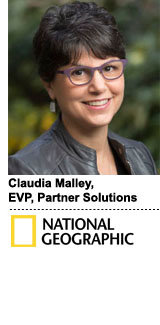
National Geographic may be rooted in traditional media, but these days it’s all about cross-channel.
Last year, Nat Geo doubled down on digital extensions through platforms such as Apple News to support the launch of “Genius,” its new scripted TV series that depicts the life of Albert Einstein.
Nat Geo, which began 130 years ago as a scientific journal and morphed into a household magazine media brand, also tapped its 412 million-strong social media following to promote “Chasing Genius,” a campaign sponsored by GlaxoSmithKline last summer.
The campaign crowdsourced ideas and videos from consumers addressing world issues like global hunger, awarding $25,000 to four winning inventors.
By distributing editorial and branded content across its digital, social and broadcast footprint, Nat Geo drove 19.2 million video views and 225 million impressions throughout the three-month campaign.
Now, the broadcaster is back with another brand, Sprint, which will sponsor a second installment of the campaign in the build-up to “Genius’” TV premiere in April.
Claudia Malley, EVP of partner solutions for Nat Geo and former publisher of National Geographic’s print magazine, spoke with AdExchanger about how the broadcaster is driving convergence between digital campaigns and TV tentpoles for brands.
AdExchanger: How does a broadcaster begin building a cross-platform activation like “Chasing Genius,” given the number of moving parts?
CLAUDIA MALLEY: We’re still out there talking about our television tentpoles and how partners work with us on those. But “Chasing Genius” creates this umbrella-platform approach where the partner doesn’t just have alignment with award-winning programming, but they can connect with consumers through a social impact program and a digital content platform.
It shifts the conversation from “Do you want to sponsor a program?” to “Do you want to connect to this platform that will give you real, one-to-one engagement?” It’s not just one-way communication, but a dialogue with a community of consumers.
What learnings from your first integrated campaign around “Genius” will you apply to this next campaign with Sprint?
What’s interesting about the platform is it’s live. And this campaign lasts only six weeks versus three months. We created so much content for the last campaign that we were able to figure out which levers pull the most engagement.
We found the newsletters and one-to-one marketing to the community to be a very effective way to get a direct connection to the consumer, as well as through social. We don’t know if we’ll achieve the same scale as the last campaign, since this campaign’s shorter, but we do think we’ll see the same rate of engagement.
How are you measuring it?
It requires multifaceted measurement. We’ll measure on straight engagement, volume and whether we are able to get more people to come forth with ideas around our community or conversation.
And then we always layer on third-party research to really measure against the ROI for a partner because we want to deliver on whatever their expectation may be, ensuring they have overall impact or lift.
For most networks, creating a cross-platform activation requires a horizontal approach spanning sales, digital marketing and content teams. Is it the same for Nat Geo?
I work within the sales group and head up our partner solutions, which you can think of as the creative and ideation behind all of our sales efforts. It includes everything from how we go to market to how we’re packaging our cross-platform assets and creating new platforms for our partners as we work through a transitioning media landscape.
We package all of our existing assets, global programming and extensions with marketing. The second way we go to market is by building out custom ideas for our partners, so we collaborate with our client solutions team to build customized and strategic opportunities for partners based on their goals and objectives.
When you’re creating [content] in this fast-changing market, every department is involved in the platform …. [from] digital to content and social marketing teams, tech and all of our back-end groups.
How does Nat Geo differentiate its pitch to brand partners when there are plenty of new media opportunities?
We still have an incredible magazine product driven by consumer revenue that’s unique in the market. We took a 130-year-old journal and turned it into a global media brand. If you pick up one of the old copies, they’re still incredibly relevant.
If you’re going to Cuba and you pick up an issue on Cuba we did in the ’30s, it’s still worth the read because it gives you this lens into the world other media companies don’t.
This interview has been condensed.
This post was syndicated from Ad Exchanger.

More Stories
MFA Sites Aren’t Going Anywhere Until There Are Incentives To End Them
TVNZ, AIA NZ, Together and NZME team up for new mental wellbeing series
Google Delays Cookie Deprecation For The Third Time